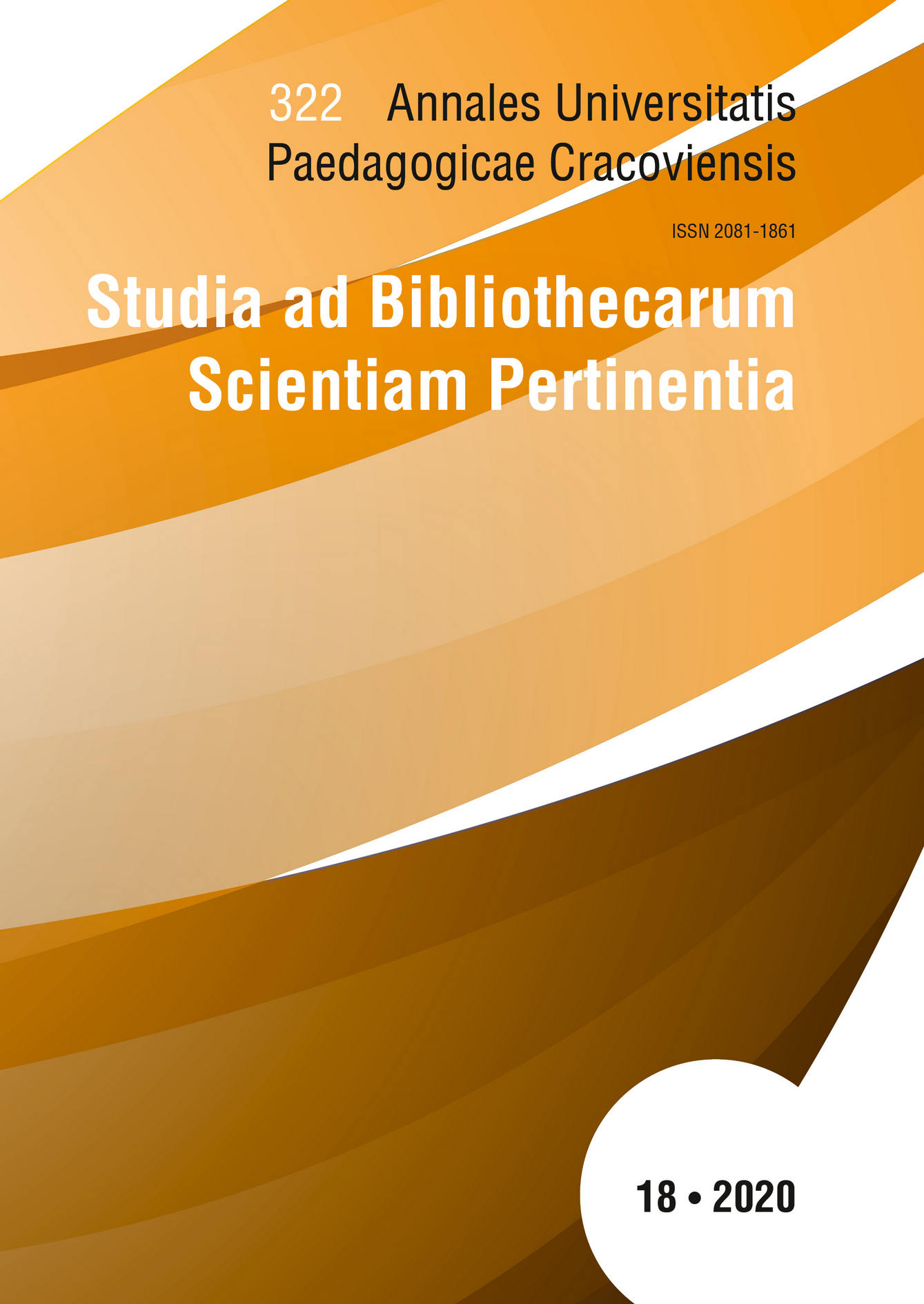Perception of information architecture by students at selected universities in Poland in the light of a survey
DOI:
https://doi.org/10.24917/20811861.18.20Keywords:
information architecture; academic education; social awareness; collective awareness; social attitudesAbstract
This article presents research results on the social (here: students’) recognition of information architecture as an educational path, awareness of the role and importance of information architecture (Eng. IA, information architecture) in a world dominated by technology. It also reviews the knowledge of the specifics of this subject matter as well as the perspectives, skills and job opportunities stemming from academic training in this discipline. The research paradigm is the interpretation of “collective consciousness” proposed by Emile Durkheim (The Division of Labour in Society, 1990), who sees it as a collection of widely distributed and accepted views, ideas and beliefs that are becoming patterns or blueprints for thinking in a particular society. Collective consciousness is a process by nature, it crystallizes over time as a result of individual experiences and environmental influences. This article presents the results of a survey conducted among students of two faculties of the Maria Curie-Skłodowska University in Lublin and (for contrast) students at the Military University of Technology in Warsaw. The research includes comparative analysis on identifying possible differences in perceiving IA by students of this course, those studying other areas of humanities and social sciences, such as media production, German studies, Portuguese studies, Italian studies, as well as students of hard sciences, i.e. computer science.
References
Chmielewski P., Architektura informacji i Światowy Dzień Architektury Informacji, „Toruńskie Studia Bibliologiczne” 2019, nr 1 (22), s. 190-197.
Durkheim E.,O podziale pracy społecznej, tłum. K. Wakar, Warszawa 1999.
Durkheim E., Zasady metody socjologicznej, tłum. J. Szacki, Warszawa 2000.
Has-Tokarz A., Malesa R., Architektura informacji w ofercie dydaktycznej Instytutu Informacji Naukowej i Bibliotekoznawstwa UMCS w Lublinie – od koncepcji do realizacji, „Folia Bibliologica” 2017, vol. 59, s. 201-214.
Kozyr-Kowalski S., Świadomość społeczna, uczłowieczenie i ubytowienie wiedzy, [w:] Człowiek i kultury. Liber amicorum. Studia poświęcone Profesorowi Mirosławowi Nowaczykowi, red. Z. Stachowski, Warszawa –Tyczyn 2001, s. 23-50
Łobocki M., Metody i techniki badań pedagogicznych, Kraków 2010.
Malesa R., Kształcenie akademickie bibliotekarzy. Doświadczenia ośrodków krajowych w kontekście zmian, „Bibliotekarz” 2020, nr 5, s. 4-8.
Malesa R., Librarian or Information Architect? Trends in the Academic Education of Information Workers in Poland, „Information, Communication, Society” 2020, s. 94-96, [online:] http://ena.lp.edu.ua/bitstream/ntb/52747/2/2020_Malesa_R-Librarian_or_Information_Architect_94-95.pdf – [dostęp: 28.01.2021].
Matysek A., Architektura informacji – nowy kierunek studiów na Uniwersytecie Śląskim w Katowicach, „Annales Universitatis Paedagogicae Cracoviensis. Studia ad Bibliothecarum Scientiam Pertinentia” 2019, t. 17, s. 364-371.
Matysek A., Architektura informacji wpiśmiennictwie zagranicznym 1982-2018. Analiza ilościowa, „Zagadnienia Informacji Naukowej. Studia Informacyjne” 2018, t. 56, nr 2 (112), s. 88-111.
NASK, Nastolatki 3.0. Raport z badania, Warszawa 2017.
Porównanie efektów kształcenia dla programu kształcenia na kierunku Architektura informacji (studia I stopnia) z efektami dla poszczególnych modułów, [online:], http://phavi.umcs.pl/at/attachments/2017/0308/190335-efekty-ksztalcenia.pdf – [dostęp: 28.01.2021].
Prensky M., Digital Natives, Digital Immigrants, „On the Horizon” 2001, Vol. 9, No. 5, s. 1-6.
Resmini A., Rosati L., Pervasive Information Architecture: Designing Cross-Channel User Experiences, Burlington, MA 2011.
Robins D., Information Architecture in Library and Information Science Curricula, „Bulletin of the American Society for Information Science and Technology” 2002, Vol. 28, Issue 2, s. 20-22, [online]: https://asistdl.onlinelibrary.wiley.com/doi/epdf/10.1002/bult.231 – [dostęp: 18.02.2021].
Roszkowski M., Każda reprezentacja jest interpretacją – w stronę hermeneutycznej koncepcji architektury informacji,„Zagadnienia Informacji Naukowej. Studia Informacyjne” 2019, t. 57, nr 2 (114), s. 61-79.
Skórka S.,Nowe wyzwania architektury informacji, „Bibliotheca Nostra” 2016, nr 2 (44), s. 10-22.
Skórka S., Architektura informacji – krótki przewodnik, [w:] Zawód infobroker: polski rynek informacji, red. S. Cisek, A. Januszko-Szakiel, Warszawa 2015, s.260-275.
Skórka S., Architektura informacji, [w:] Nauka o informacji, red. W. Babik, Warszawa 2016, s. 555-575.
Skórka S., Architektura informacji. Nowy kierunek informacji naukowej, „EBIB” 2002, nr 11, [online:], http://www.ebib.pl/2002/40/skorka.php – [dostęp: 28.01.2021].
Skórka S., Strategie poszukiwania informacji w edukacyjnym systemie hipertekstowym, „Praktyka i Teoria Informacji Naukowej i Technicznej” 2005, t.13, nr 2, s.43-48.
Świadomość społeczna, [hasło w:], [online:] https://encyklopedia.pwn.pl/haslo/swiadomosc-spoleczna;3984380.html – [dostęp: 28.01.2021].
Tafiłowski P., Architektura informacji jako problem badawczy informatologii, „Zagadnienia Informacji Naukowej. Studia Informacyjne” 2016, t. 54(2), s. 37-47.
Wurman R.S., Information Architects, Graphis Publications, New York 1997.
Ziółkowski M., Przyczynek do sposobu pojmowania świadomości społecznej, [w:] Świadomość jednostkowa a świadomość społeczna, red. J. Brzeziński, L. Nowak, Warszawa –Poznań 1984, s. 9-36.
Ziółkowski M., Wiedza, Jednostka. Społeczeństwo. Zarys koncepcji socjologii wiedzy, Warszawa 1989.
Downloads
Published
How to Cite
Issue
Section
License
Copyright (c) 2020 Annales Universitatis Paedagogicae Cracoviensis | Studia ad Bibliothecarum Scientiam Pertinentia

This work is licensed under a Creative Commons Attribution-NonCommercial-NoDerivatives 4.0 International License.

